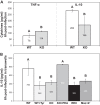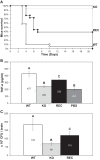Host-pathogen interaction and signaling molecule secretion are modified in the dpp3 knockout mutant of Candida lusitaniae
- PMID: 24191303
- PMCID: PMC3911850
- DOI: 10.1128/IAI.01263-13
Host-pathogen interaction and signaling molecule secretion are modified in the dpp3 knockout mutant of Candida lusitaniae
Abstract
Candida lusitaniae is an emerging opportunistic yeast and an attractive model to discover new virulence factors in Candida species by reverse genetics. Our goal was to create a dpp3Δ knockout mutant and to characterize the effects of this gene inactivation on yeast in vitro and in vivo interaction with the host. The secretion of two signaling molecules in Candida species, phenethyl alcohol (PEA) and tyrosol, but not of farnesol was surprisingly altered in the dpp3Δ knockout mutant. NO and reactive oxygen species (ROS) production as well as tumor necrosis factor alpha (TNF-α) and interleukin 10 (IL-10) secretion were also modified in macrophages infected with this mutant. Interestingly, we found that the wild-type (WT) strain induced an increase in IL-10 secretion by zymosan-activated macrophages without the need for physical contact, whereas the dpp3Δ knockout mutant lost this ability. We further showed a striking role of PEA and tyrosol in this modulation. Last, the DPP3 gene was found to be an essential contributor to virulence in mice models, leading to an increase in TNF-α secretion and brain colonization. Although reinsertion of a WT DPP3 copy in the dpp3Δ knockout mutant was not sufficient to restore the WT phenotypes in vitro, it allowed a restoration of those observed in vivo. These data support the hypothesis that some of the phenotypes observed following DPP3 gene inactivation may be directly dependent on DPP3, while others may be the indirect consequence of another genetic modification that systematically arises when the DPP3 gene is inactivated.
Figures






Similar articles
-
Mediator Subunit Med15 Regulates Cell Morphology and Mating in Candida lusitaniae.J Fungi (Basel). 2023 Mar 8;9(3):333. doi: 10.3390/jof9030333. J Fungi (Basel). 2023. PMID: 36983501 Free PMC article.
-
Farnesol and Tyrosol: Secondary Metabolites with a Crucial quorum-sensing Role in Candida Biofilm Development.Genes (Basel). 2020 Apr 18;11(4):444. doi: 10.3390/genes11040444. Genes (Basel). 2020. PMID: 32325685 Free PMC article. Review.
-
Dipeptidyl peptidase 3 modulates the renin-angiotensin system in mice.J Biol Chem. 2020 Oct 2;295(40):13711-13723. doi: 10.1074/jbc.RA120.014183. Epub 2020 Jun 16. J Biol Chem. 2020. PMID: 32546481 Free PMC article.
-
Effect of farnesol on a mouse model of systemic candidiasis, determined by use of a DPP3 knockout mutant of Candida albicans.Infect Immun. 2007 Apr;75(4):1609-18. doi: 10.1128/IAI.01182-06. Epub 2007 Feb 5. Infect Immun. 2007. PMID: 17283095 Free PMC article.
-
Quorum sensing by farnesol revisited.Curr Genet. 2017 Oct;63(5):791-797. doi: 10.1007/s00294-017-0683-x. Epub 2017 Feb 28. Curr Genet. 2017. PMID: 28247023 Review.
Cited by
-
Mediator Subunit Med15 Regulates Cell Morphology and Mating in Candida lusitaniae.J Fungi (Basel). 2023 Mar 8;9(3):333. doi: 10.3390/jof9030333. J Fungi (Basel). 2023. PMID: 36983501 Free PMC article.
-
Farnesol and Tyrosol: Secondary Metabolites with a Crucial quorum-sensing Role in Candida Biofilm Development.Genes (Basel). 2020 Apr 18;11(4):444. doi: 10.3390/genes11040444. Genes (Basel). 2020. PMID: 32325685 Free PMC article. Review.
-
Biological Studies and Target Engagement of the 2- C-Methyl-d-Erythritol 4-Phosphate Cytidylyltransferase (IspD)-Targeting Antimalarial Agent (1 R,3 S)-MMV008138 and Analogs.ACS Infect Dis. 2018 Apr 13;4(4):549-559. doi: 10.1021/acsinfecdis.7b00159. Epub 2017 Nov 7. ACS Infect Dis. 2018. PMID: 29072835 Free PMC article.
References
-
- Kullberg BJ, Filler SG. 2002. Candidemia, p 327–340 In Calderone RA. (ed), Candida and candidiasis. ASM Press, Washington, DC
-
- Pfaller MA, Jones RN, Messer SA, Edmond MB, Wenzel RP. 1998. National surveillance of nosocomial blood stream infection due to Candida albicans: frequency of occurrence and antifungal susceptibility in the SCOPE Program. Diagn. Microbiol. Infect. Dis. 31:327–332. 10.1016/S0732-8893(97)00240-X - DOI - PubMed
-
- Calderone RA. (ed). 2002. Candida and candidiasis. ASM Press, Washington
Publication types
MeSH terms
Substances
LinkOut - more resources
Full Text Sources
Other Literature Sources
Miscellaneous

